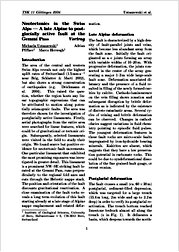Neotectonics in the Swiss Alps—A late Alpine to postglacially active fault at the Gemmi Pass
Ustaszewski, Michaela
Pfiffner, Adrian
Herwegh, Marco
Universitätsverlag Göttingen
Sammelband- / Konferenzbeitrag
Verlagsversion
Deutsch
Ustaszewski, Michaela; Pfiffner, Adrian; Herwegh, Marco, 2006: Neotectonics in the Swiss Alps—A late Alpine to postglacially active fault at the Gemmi Pass. In: Philipp, S.; Leiss, B; Vollbrecht, A.; Tanner, D.; Gudmundsson, A. (eds.): 11. Symposium "Tektonik, Struktur- und Kristallingeologie"; 2006, Univ.-Verl. Göttingen, p. 235 - 238., , DOI: 10.23689/fidgeo-1847.
 |
Dokument öffnen: |
The area of the central and western
Swiss Alps reveals not only the highest
uplift rates of Switzerland (1.5mma−1
near Brig, Schlatter & Marti 2002),
but also shows a strong concentration
of earthquakes (e.g. Deichmann et
al. 2004). This raised the question,
whether the region hosts any linear
topographic expressions that can
be attributed to motion along potentially
seismogenic faults. The area was
therefore chosen for the investigation of postglacially active lineaments. Firstly,
aerial photographs from the entire area
were searched for linear features, which
could be of gravitational or tectonic origin.
Subsequently, selected lineaments
were visited in the field to study their
origin. We found scarce but positive evidence
for neotectonic fault movements.
One particular lineament that exhibited
the most promising exposures was investigated
in greater detail. This lineament
is a prominent NW–SE striking fault located
at the Gemmi Pass, runs perpendicularly
to the regional fold axes and
cuts through the Helvetic nappe stack.
The position and orientation of the fault
discounts gravitational reactivation. A
close examination of the fault rocks reveals
a long term evolution of this fault
starting already at a late stage of Alpine
nappe emplacement and related deformation.

